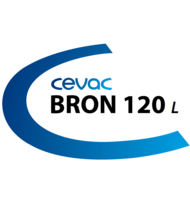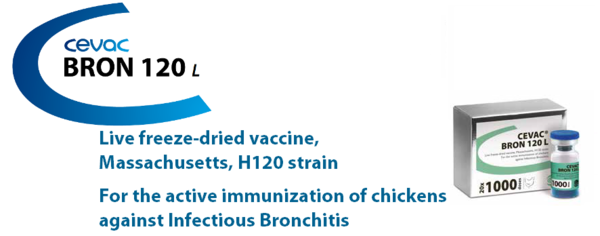Eye-drop Method
Fill the vaccine vial with diluent till 3/4 of the total volume to dissolve the lyophilized vaccine. Pour and dilute the vaccine suspension into the remaining diluent contained in the plastic bottle with the dropper. Sterile needle and syringe should be used for this preparation.
30 ml of diluent should be used to administer 1,000 doses.
Hold the bird to be vaccinated with the head tilted to one side.
Hold the plastic bottle with the dropper tip down, gently press the sides, dropping one drop of vaccine on to the eye of the bird. Be sure the vaccine spreads over the eye before releasing the bird.
Spray Method
Use sterile distilled water and reconstitute the vaccine as explained in the eye drop method.
It is preferable to use a sprayer working under constant pressure. Use the right nozzle size (as prescribed by the sprayer manufacturer) and tune the pressure to produce a coarse spray.
Delivery rate varies from 0.2 to 0.3 litre / 1000 day old chicks in a box, from 0.5 to 1 litre / 1000 birds on litter. The volume may change according to the weather conditions.
The birds should be slightly wet after vaccination.
Vaccinate during the coolest time of the day. Switch of the heaters and shut down the ventilation.
Gather the birds on the ground or in boxes. Dim the lighting and spray 20 - 30 cm above the birds.
Return to spray a second time.
Leave the birds quite for at least 15 minutes after vaccination. Switch on ventilation and heaters.
Drinking Water Method
Do not use a disinfectant in the drinking water for a period of 48 hours prior to and 24 hours after vaccination.
When a chlorine pump is used, switch it of for the same period of time.
The waterers should be thoroughly cleaned before vaccination. No disinfectant shall be used.
Close the water distribution system, raise and empty the nipple lines or empty the waterers.
Water withholding period varies according to age of birds and climatic conditions (average 1 hour 30 min).
Prepare only the amount of vaccine to be used immediately.
Use only plastic material and tools to prepare and administer vaccine.
Prepare the required volume of water that will be consumed by the birds in 2 hours. This volume may change according to the climatic and environmental conditions.
As an aid in preserving the virus activity, neutralise the chlorine with 2.5 g of skimmed milk powder per litre of water or 15 mg of sodium thiosulfate per litre of water. Do not use water containing high concentrations of metal ions.
Mix the vaccine with clean, cool, non-chlorinated water by opening the vials under the water and let stand for 10 minutes.
Open the water system when the color of the water changes (blue dye), lower the lines and check distribution throughout the house. When the tank is empty: fill it with a solution of skimmed milk powder, let it stand for 10 min., then open the water system to flush out the remaining vaccine solution in the pipeworks.
Vaccine solution can be distributed also manually by workers using plastic watering cans.
If you have any questions, please do not hesitate to contact us or send us an e-mail to contact.vn@ceva.com!
COMPOSITION
CEVAC® BRON 120 L contains the Massachusetts H-120 strain of infectious bronchitis virus in live, freeze-dried form.
The embryonated hen eggs used in the production of the vaccine are obtained from specified-pathogen-free (SPF) flocks.
ADMINISTRATION AND DOSAGE
Primary vaccination should be carried-out with CEVAC® BRON 120 L by eye-drop or spray method, as from 1 day of age. Booster vaccination is recommended three to four weeks later by spray or drinking water. For pullets, a second booster vaccination is recommended at 10 to 12 weeks of age.
SIDE EFFECT
Rarely, catarrhal respiratory symptoms appear 4 to 6 days following vaccination but disappear in a few days.
STORAGE
Between 2°C and 8°C, protected from light
FOR VETERINARY USE ONLY


 Corporate Website
Corporate Website
 Africa
Africa
 Argentina
Argentina
 Asia
Asia
 Australia
Australia
 Belgium
Belgium
 Brazil
Brazil
 Bulgaria
Bulgaria
 Canada (EN)
Canada (EN)
 Chile
Chile
 China
China
 Colombia
Colombia
 Denmark
Denmark
 Egypt
Egypt
 France
France
 Germany
Germany
 Greece
Greece
 Hungary
Hungary
 Indonesia
Indonesia
 Italia
Italia
 India
India
 Japan
Japan
 Korea
Korea
 Malaysia
Malaysia
 Mexico
Mexico
 Middle East
Middle East
 Netherlands
Netherlands
 Peru
Peru
 Philippines
Philippines
 Poland
Poland
 Portugal
Portugal
 Romania
Romania
 Russia
Russia
 South Africa
South Africa
 Spain
Spain
 Sweden
Sweden
 Thailand
Thailand
 Tunisia
Tunisia
 Turkey
Turkey
 Ukraine
Ukraine
 United Kingdom
United Kingdom
 USA
USA
 Vietnam
Vietnam


